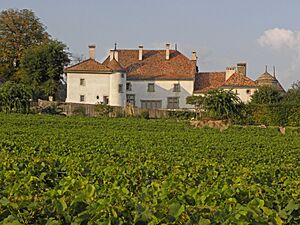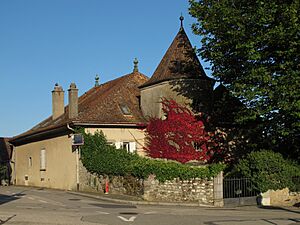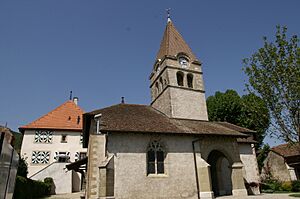Bursins facts for kids
Quick facts for kids
Bursins
|
||
|---|---|---|
 |
||
|
||
| Country | Switzerland | |
| Canton | Vaud | |
| District | Nyon | |
| Area | ||
| • Total | 3.37 km2 (1.30 sq mi) | |
| Elevation | 483 m (1,585 ft) | |
| Population
(Dec 2020 )
|
||
| • Total | 779 | |
| • Density | 231.2/km2 (598.7/sq mi) | |
| Demonym(s) | Les Bursinois Lè Caca-drâtse Lè Medze-faye |
|
| Postal code |
1183
|
|
| Localities | Le Vernay | |
| Surrounded by | Burtigny, Gilly, Bursinel, Dully, Luins, Vinzel | |
Bursins is a small town, also called a municipality, located in the Nyon district of the Vaud canton in Switzerland. It's a charming place known for its beautiful scenery and history.
Contents
A Look Back: Bursins' History
Bursins has a long history! It was first written about in the year 1011, where it was called Bruzinges. A bit later, before 1031, old records mentioned it as Brucins. This shows that Bursins has been around for over 1000 years!
Exploring Bursins' Geography
Bursins covers an area of about 3.4 square kilometers (1.3 square miles). A big part of this land, about 55%, is used for farming. This includes fields for crops and areas for vineyards. Another large part, about 32%, is covered by forests. The remaining 13.6% of the land is where buildings and roads are located.
Most of the built-up area includes homes and other buildings. Roads and paths make up another part. The forests are mostly dense woods, with some smaller groups of trees. For farming, most land is used for growing crops. A good portion is also used for vineyards, which are important here.
Bursins used to be part of the Rolle District. But in 2006, it became part of the new Nyon district. The town is located in the "Côte" region, which is famous for producing wine. Bursins includes the main village and smaller areas called hamlets, like Le Molard and parts of Le Vernay.
Understanding Bursins' Coat of Arms
The official symbol of Bursins, its coat of arms, has a special design. It shows a silver background with a red "chevron," which is a V-shaped line. At the top, there are two bunches of red grapes. At the bottom, there is a red purse. These symbols likely represent the town's history, perhaps its wine production and trade.
Who Lives in Bursins? Population Facts
Bursins has a population of about 720 people. Around 23% of the people living here are from other countries. Over the last ten years, the population of Bursins has grown quite a lot, by about 45%. Most of this growth happened because more people moved into Bursins than moved out. Births and deaths also played a smaller role.
Most people in Bursins speak French, which is the main language. German is the second most common language, followed by English. A few people also speak Italian.
Let's look at the age groups in Bursins:
- About 12.8% of the population are children aged 0 to 9.
- Another 12.5% are teenagers aged 10 to 19.
- Adults aged 20 to 59 make up about 54% of the population.
- Seniors, aged 60 and older, make up about 19.9% of the population.
Most households in Bursins have about 2.4 people living in them. There are many different types of households, including single people, married couples with or without children, and single parents.
The chart below shows how the population of Bursins has changed over many years:

Famous People from Bursins
A well-known person who lived in Bursins was the English actor Peter Ustinov. He passed away in 2004 and is buried in Bursins.
Important Heritage Sites in Bursins
Bursins has some very important historical places. The Swiss Reformed Church of Saint-Martin is one of them. Another important site is the Tuilerie de Vinzel avec four Hoffmann, which is an old tile factory with a special type of oven. These two sites are listed as Swiss heritage sites of national importance. The entire village of Bursins is also recognized as part of the Inventory of Swiss Heritage Sites, meaning it has special historical value.
Bursins' Economy: How People Work
In Bursins, people work in different types of jobs. About 37 people work in the primary economic sector, which means jobs related to farming and agriculture. There are about 10 businesses in this area. Around 72 people work in the secondary sector. These jobs include manufacturing (making things) and construction (building things). There are 9 businesses in this sector. The largest number of people, 296, work in the tertiary sector. This includes jobs in services like sales, transportation, hotels, restaurants, and education. There are 28 businesses in this sector.
Many people who live in Bursins also travel to other towns for work. About 6.3% of the people who come to Bursins for work are from outside Switzerland. Most people use a private car to get to work, while a smaller number use public transportation.
Religion in Bursins
Based on information from 2000, many people in Bursins belong to Christian churches. About 21% are Roman Catholic, and 55% belong to the Swiss Reformed Church. There are also smaller numbers of people who belong to other Christian churches. Some people do not belong to any church or have different beliefs.
Learning and Education in Bursins
Education is important in Bursins. About 38.5% of the adults have finished high school (upper secondary education). Around 20.3% have gone on to higher education, like university or a specialized college.
In the 2009/2010 school year, there were 92 students in the Bursins school area. Children usually start with two years of pre-school, which is not mandatory but is provided. Then, they attend primary school for four years. There were 50 students in primary school in Bursins. After primary school, students go to lower secondary school for six years. There were 41 students in these schools. A few students are also homeschooled or attend other special schools.
Some students who live in Bursins go to schools in other towns. Also, some students from other towns come to school in Bursins.
See also
 In Spanish: Bursins para niños
In Spanish: Bursins para niños







